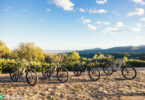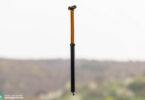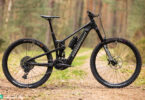With the S-Works Kenevo SL, Specialized enter the race with a capable yet superlight eMTB. The smaller motor and battery bring several advantages to the trail – and some disadvantages too! How did the Kenevo fare against the competition in our eMTB 2022 group test?
For an overview of the test fleet head to the group test: The best eMTB of 2022 – 13 models in review
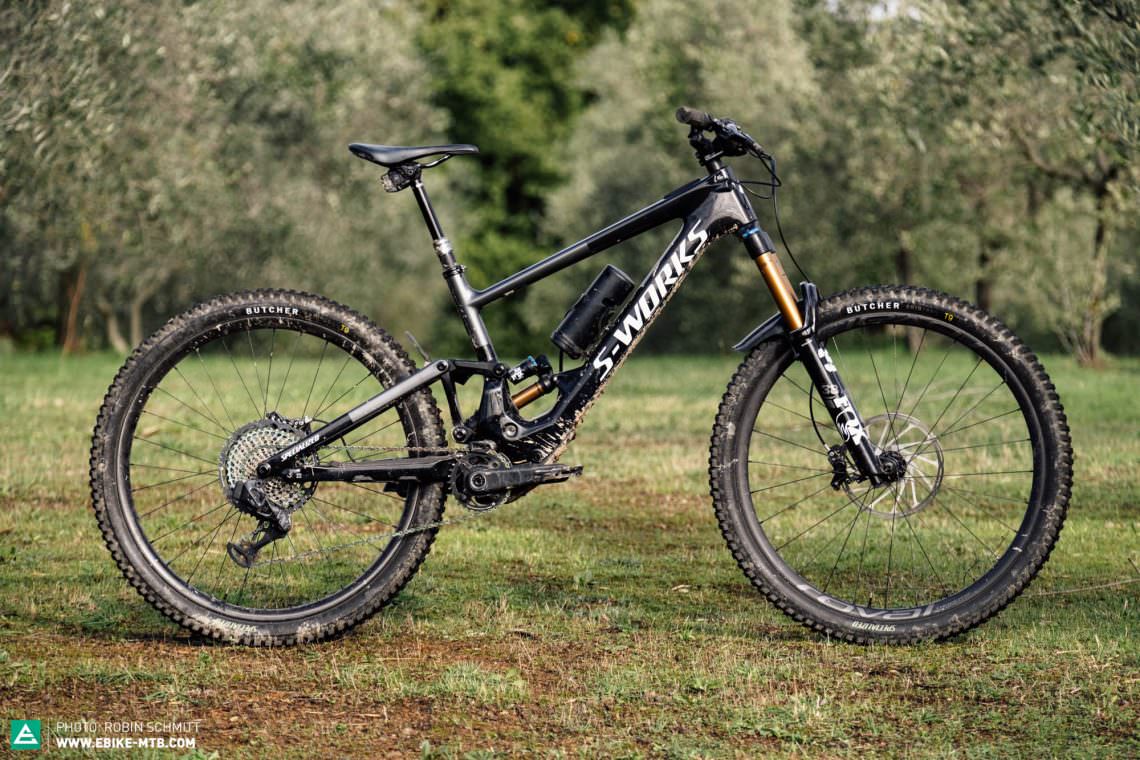
19.9 kg in size S4 | € 15,000 | Manufacturer’s website
The Specialized S-Works Kenevo SL is the electrified evolution of Specialized’s analogue bruiser, the Enduro and at first glance, it’s hard to tell the two bikes apart. For the slim-looking Kenevo SL, Specialized rely on a compact Specialized SL 1.1-Motor which produces 35 Nm torque and draws its power from a lightweight 320 Wh battery. As a result, the Kenevo belongs in a category of its own, entering the race as the outsider in this test. The advantage? The smaller motor and battery ensure both lower weight and lower power consumption, allowing the Kenevo to achieve a range similar to that of a conventional eMTB all-rounder, provided you’re fit enough. For epic backcountry adventures, you can use the optional 160 Wh range extender, which weighs 1.2 kg and fits in the bottle cage of the Kenevo. All frame details are well thought out and functional, from the neat cable routing with cable clamps to the soft chainstay protector, all the way to the integrated multi-tool. However, the real highlight is the seamless integration of the motor system, which is by far the neatest in the entire test field. Just as neat is the MasterMind display integrated into the top tube which, together with the Mission Control app, lets you perform over-the-air updates, tune the assistance modes and configure the size and number of data fields on the display.

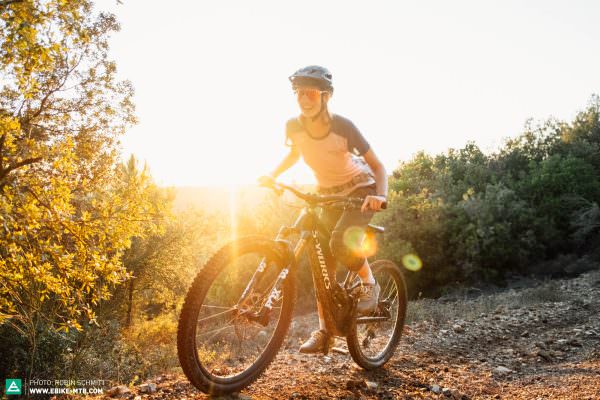
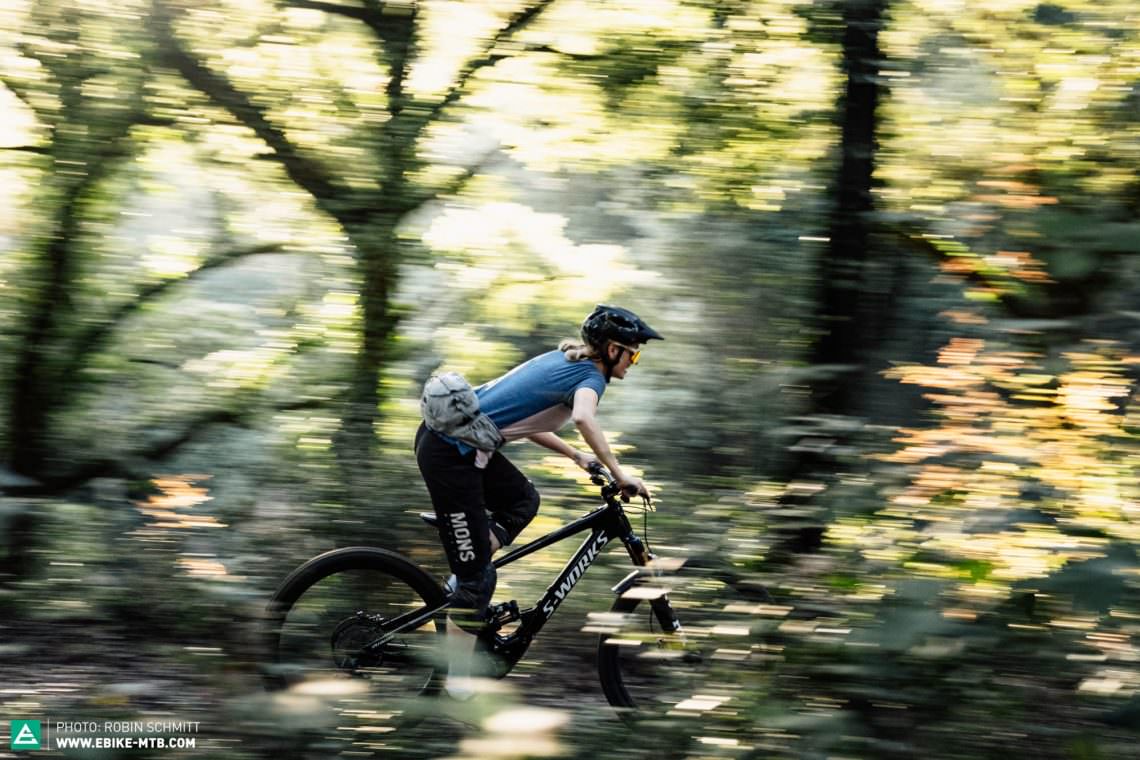
Only the best components? The spec of the Specialized S-Works Turbo Kenevo SL
At 18.7 kg without the range extender, the Kenevo is the lightest bike in the entire test field, and at € 15,000, the most expensive one, sharing that honour with the Levo. In return you get exceptional finishing quality and top-end components, which have largely been chosen for trail performance. The Kenevo SL relies on a FOX 38 Factory GRIP2 suspension fork and FOX X2 Factory shock, both controlling 170 mm travel. Shifting is taken care of by a wireless 12-speed SRAM XX1 Eagle AXS drivetrain while SRAM CODE RSC with a massive 220 mm rotor at the front and 200 mm at the rear do stopping duties – excellent! For the wheels and tires, Specialized rely on their own components, combining a Roval Traverse SL carbon wheelset and 2.3″ Butcher tires front and rear. Unfortunately, the tires come in the puncture-prone GRID Trail casing which requires higher air pressures to prevent pinch flats and irreversible damage to the expensive carbon rims. However, higher tire pressures come at the expense of traction and support, preventing you from unlocking the full potential of the Kenevo.
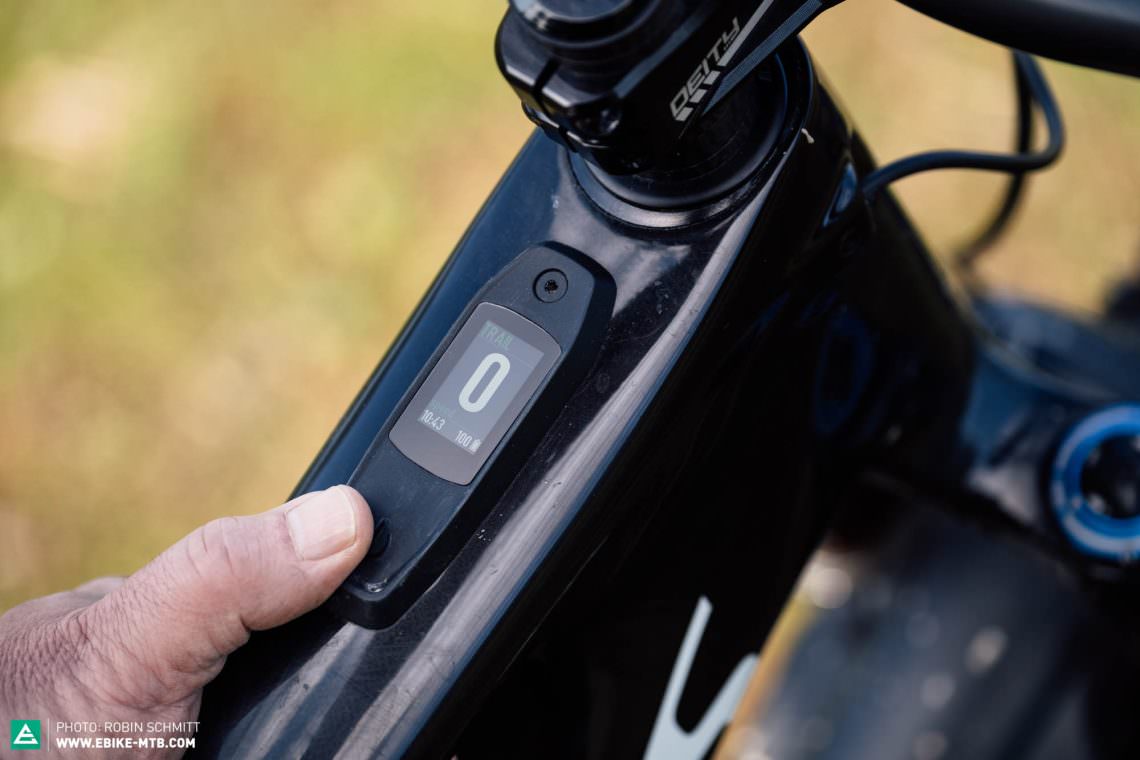
Best system integration in the entire test field! The lynchpin of the ecosystem is the MasterMind fitted on the top tube, which, together with the Mission Control app, enables numerous customisation options and over-the-air updates that are meant to constantly improve the performance of the bike.
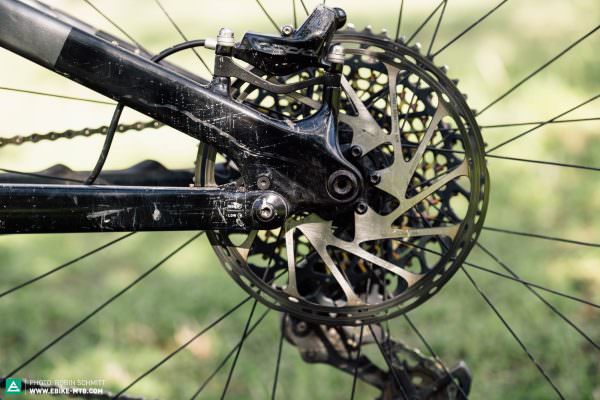
The geometry of the Specialized S-Works Kenevo SL can be adjusted using different headset cups and a flip-chip in the chainstays. We recommend combining the short chainstay and middle head angle settings for the most balanced ride.
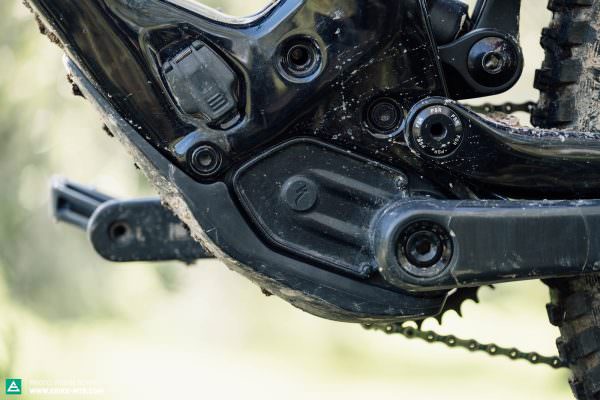
Specialized’s Light eMTB relies on the compact, lightweight SL 1.1 motor, which weighs 1.95 kg, produces just 35 Nm torque and draws its power from an integrated 320 Wh battery. Read more about Specialized’s motor system in our big motor group test.
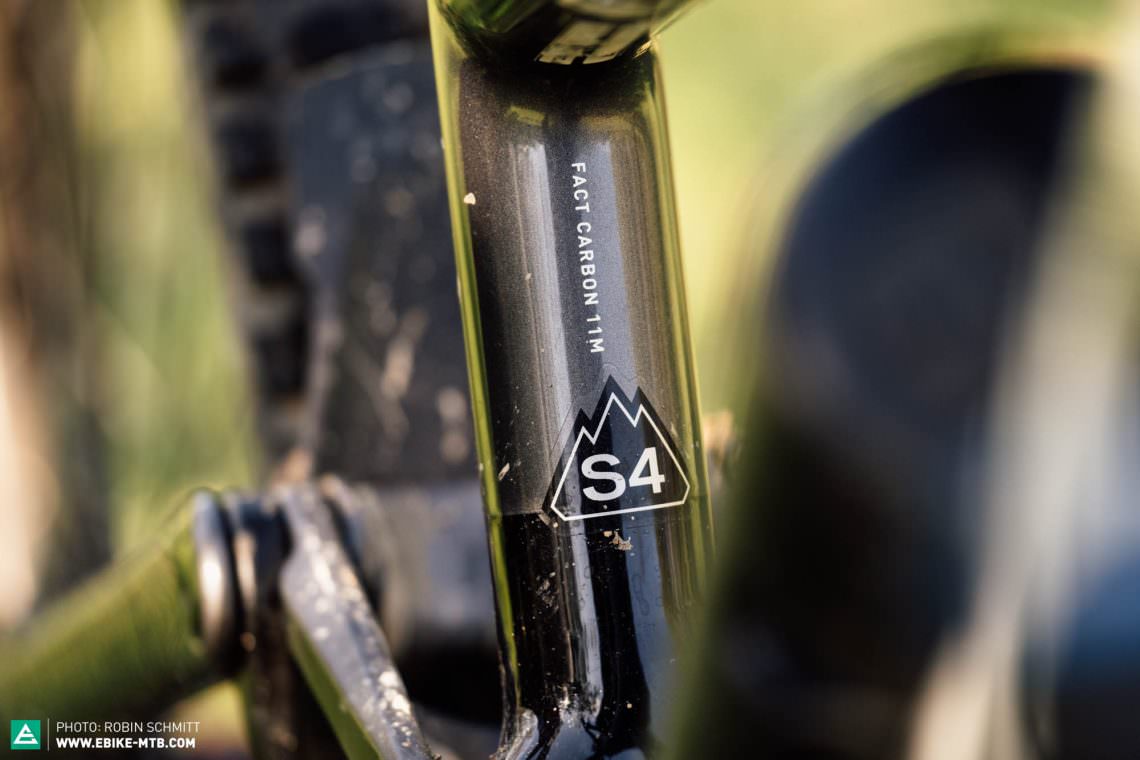
The short insertion depth of the seat tube defeats the whole purpose of the ‘S’ sizing system. Furthermore, the RockShox Reverb AXS dropper limits freedom of movement on the bike, which makes it a poor match for the Kenevo SL.
Specialized S-Works Turbo Kenevo SL
€ 15,000
Specifications
Motor Specialized SL 1.1 35 Nm
Battery Specialized SL1.1 320 +160 Wh
Display Specialized MasterMind
Fork FOX 38 Factory GRIP2 170 mm
Rear Shock FOX X2 Factory 170 mm
Seatpost RockShox Reverb AXS 170 mm
Brakes SRAM CODE RSC 220/200 mm
Drivetrain SRAM XX1 Eagle AXS 1x12
Stem DEITY Copperhead 50 mm
Handlebar Roval Traverse SL Carbon 800 mm
Wheelset Roval Traverse SL29 29"
Tires Specialized Butcher GRID TRAIL 2.3"
Technical Data
Size S2–S5
Weight 19.9 kg
Perm. total weight 128 kg
Max. payload (rider/equipment) 108 kg
Trailer approval no
Kickstand mount no
Specific Features
SWAT Multitool
Range Extender
various Geometry options
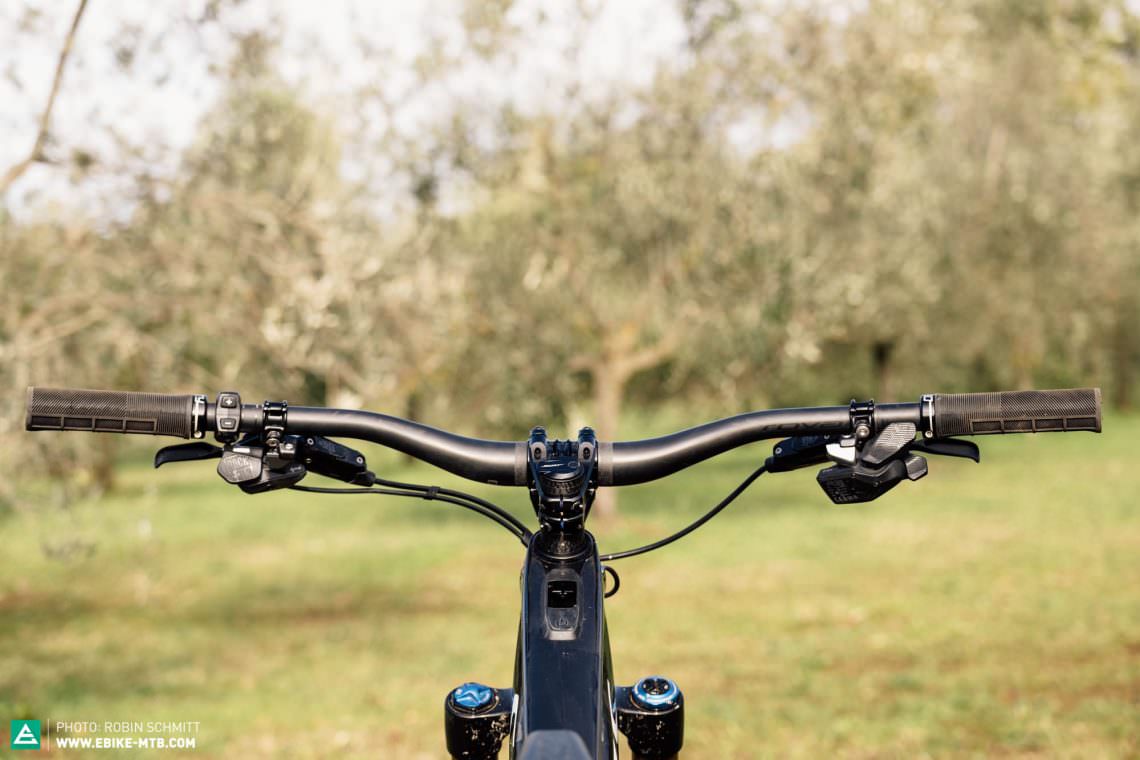
Wireless SRAM AXS components and Matchmaker clamps ensure a tidy cockpit and excellent ergonomics.
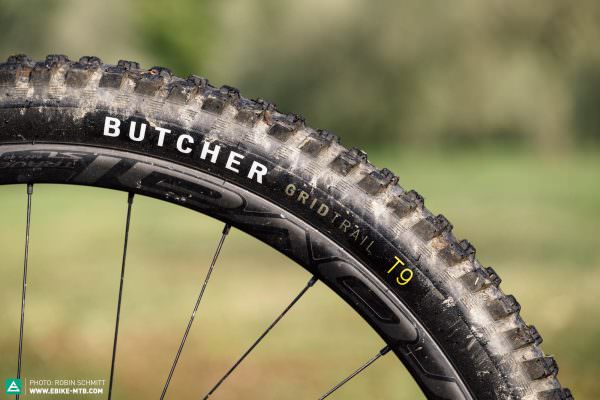
Thin-casings and expensive carbon rims are not a good look! We recommend upgrading the tires to a more robust model with a tough casing to avoid pinch flats and costly rim damage, as well as improve traction.
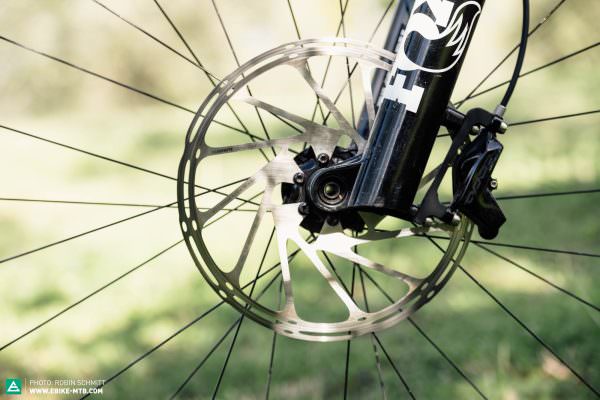
SRAM CODE RSC brakes with a big 220 mm front rotor ensure powerful deceleration, excellent modulation and a consistent bite point – we love it!
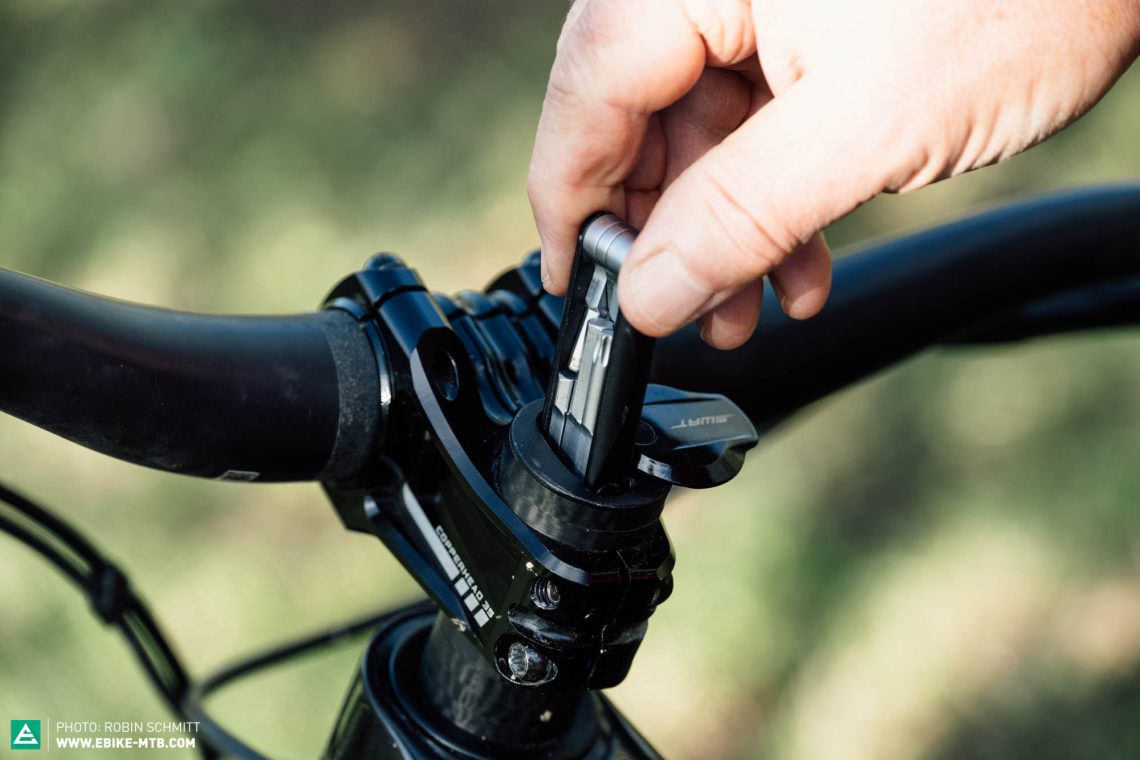
The SWAT multi-tool hidden in the steerer includes all the tools for essential trailside repairs.
The geometry and riding position of the Specialized S-Works Turbo Levo SL
The S-Works Turbo Kenevo SL uses Specialized’s ‘S’ sizing system, which usually allows you to choose the frame size based on your desired reach and riding characteristics. Unfortunately, that’s not the case with the S-Works Kenevo SL, because the 170 mm RockShox Reverb AXS dropper post can’t be inserted all the way into the frame, restricting freedom movement and making it hard to size up. A flip-chip in the chainstays and special headset cups allow you to adjust the geometry. For a balanced ride, we recommend combining the short chainstay setting and middle head angle position. The long frame ensures a stretched and very sporty pedalling position, making the Kenevo SL less suited to long rides on level ground.
| Size | S2 | S3 | S4 | S5 |
|---|---|---|---|---|
| Seat tube | 400 mm | 420 mm | 440 mm | 465 mm |
| Head tube | 105 mm | 115 mm | 125 mm | 135 mm |
| Head angle | 63.5° | 63.5° | 63.5° | 63.5° |
| Seat angle | 76.0° | 76.0° | 76.0° | 76.0° |
| Chainstays | 447 mm | 447 mm | 447 mm | 447 mm |
| BB Drop | 25 mm | 25 mm | 25 mm | 25 mm |
| Wheelbase | 1,228 mm | 1,258 mm | 1,287 mm | 1,316 mm |
| Reach | 435 mm | 460 mm | 485 mm | 510 mm |
| Stack | 618 mm | 626 mm | 635 mm | 644 mm |
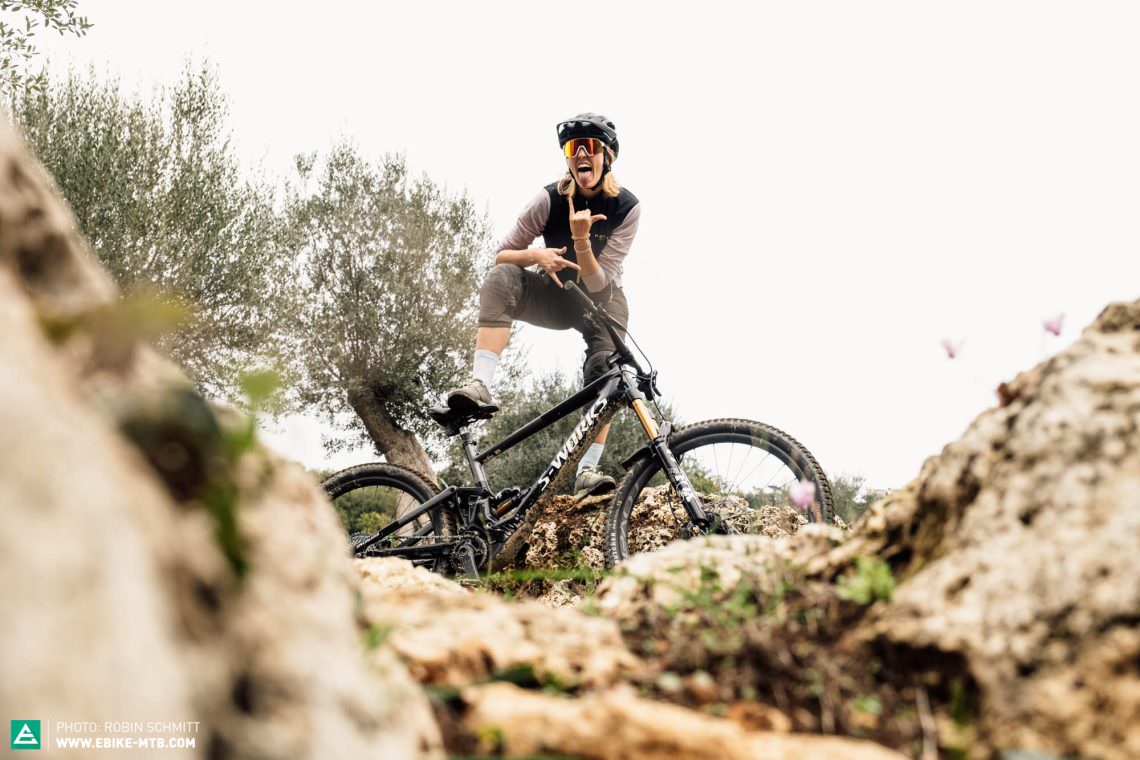
Shorts Mons Royale Momentum | Kneepad iXS FLOW EVO+
Shoes Five Ten Freerider Pro | Socks Selfmade
A slow climber, a beast downhill – The Specialized S-Works Turbo Kenevo SL on the trail
Uphill, the motor of the Kenevo SL is a lot weaker than the Orbea’s torque-limited EP8 RS and requires more physical effort than any other bike on test. As a result, the Kenevo SL isn’t particularly great fun to ride on flowing or technical uphill trails. With its 35 Nm torque, it supports you on moderate fire roads but doesn’t carry you to the trailhead as eagerly as all other bikes in this test. However, the Kenevo SL really comes to life downhill.
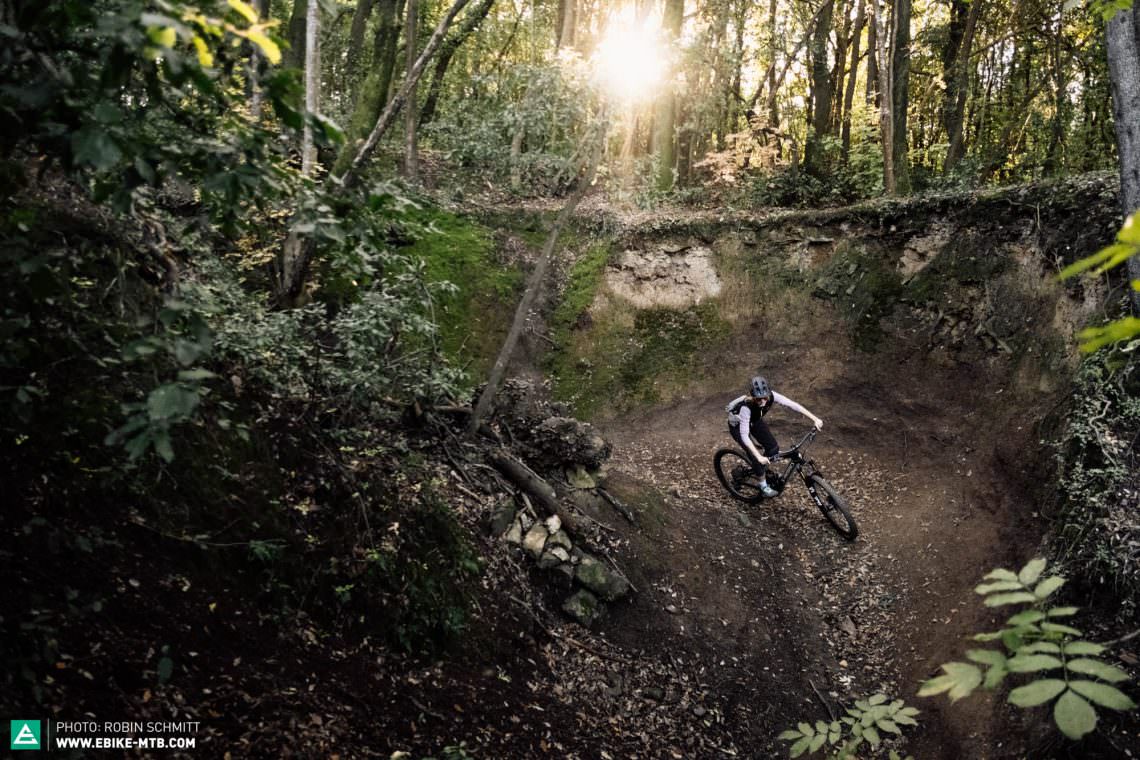
ICompared to the purebred eMTB all-rounders in this test, the Kenevo SL feels like an analogue MTB with a generous tailwind. However, it’s downhill that the Kenevo really comes to life.
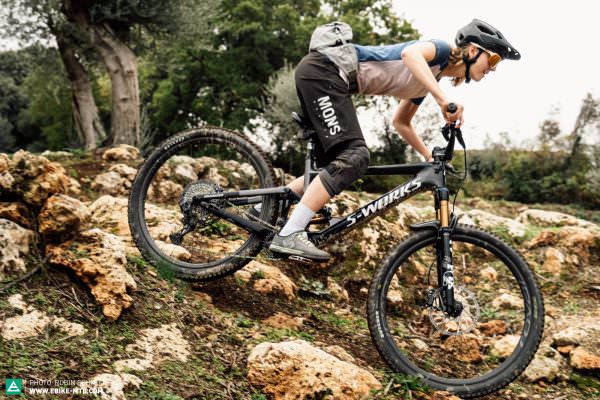
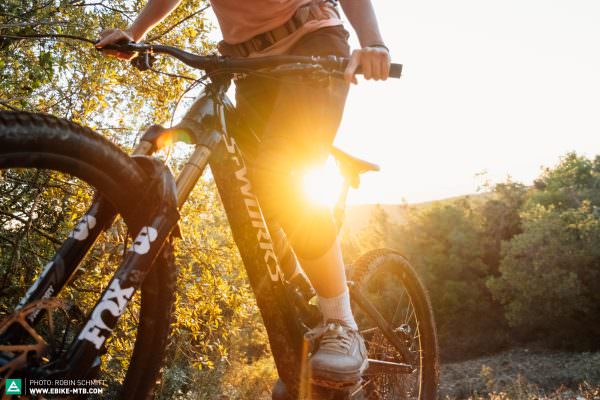
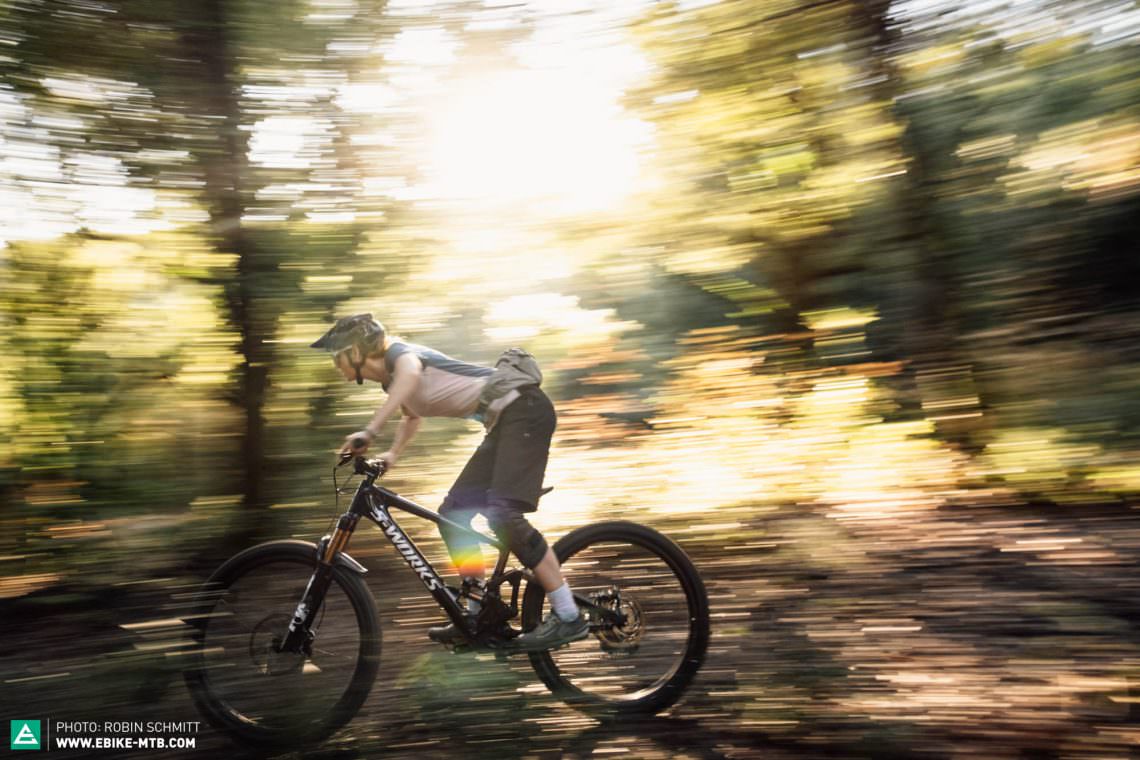
With the Kenevo SL, the climb is just a means to an end. The real fun starts downhill, where the agile yet composed handling invites you to step on the gas! Test rider Anna seems to be enjoynig the adrenaline rush!
The Specialized S-Works Turbo Kenevo SL downhill
As soon as you drop into the valley, the Kenevo SL tears off its outsider label and shows its opponents what it’s capable of. Hardly any other bike in this test is as nimble and at the same time as composed and easy to control as the Kenevo. However, the Specialized really comes to life on fast trails and rough bike park tracks, where it carries insane amounts of speed and negotiates nasty rock gardens and huge gaps with stoic composure. Only two bikes are better in this regard, the Yeti 160E T1 and Rocky Mountain Altitude Powerplay C70. Unfortunately, on big drops and hard hits, the rear suspension tends to blow through its travel. If you ride hard, we recommend adding volume spacers for more progression. On steep and technical descents, the slack head angle, high front, excellent traction and intuitive handling instill huge amounts of confidence but the dropper post restricts freedom of movement. On easy and flat trails, the Kenevo SL gets easily bored, requiring a good amount of speed to maintain its agile handling and deliver fun.
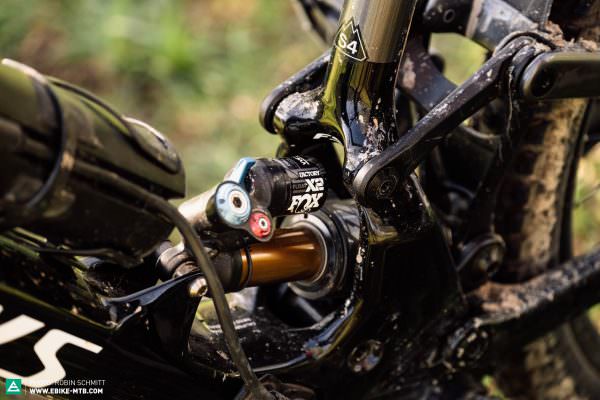
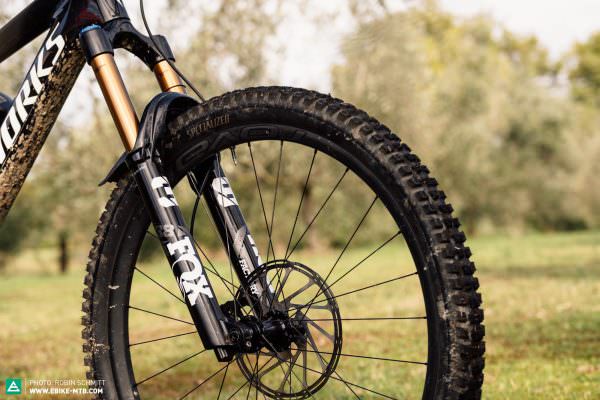
Tuning tips: add volume spacers to the shock | more robust tires (e.g. Specialized GRID Gravity casing)
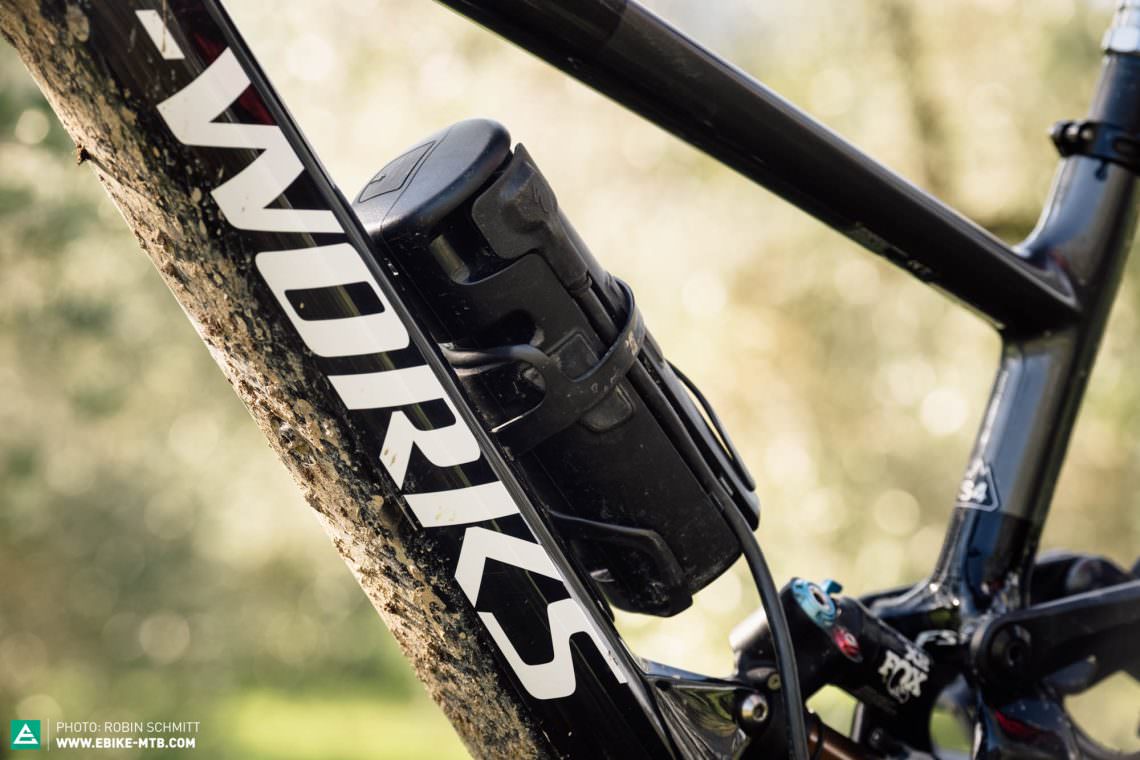
The optional 160 Wh range extender fits in the bottle cage of the Kenevo and boosts the battery capacity to a total of 480 Wh. In combination with the weak SL 1.1 motor, this allows you to embark on epic climbs – provided you’re fit! With its weaker motor, the Kenevo requires far more physical effort than any other bike in our test field.
Riding Characteristics
7Agility
- sluggish
- playful
Stability
- nervous
- stable
Handling
- demanding
- balanced
Riding fun
- boring
- lively
Motor feeling
- digital
- natural
Motor power
- weak
- strong
Value for money
- poor
- top
Conclusion
With the weakest climbing performance and the least long-distance comfort in the entire test field, the Specialized S-Works Turbo Kenevo SL stood no chance of winning our 2022 eMTB group test. On the other hand, Specialized’s E-bruiser delivers an impressive performance on rough and fast trails and jump lines, where it shreds past most of its competitors with its lively handling and composed character. The integration of the motor system and MasterMind display, the modular battery concept and the details are excellent too.
Tops
- system integration
- extremely composed at high speed
- modular battery concept
Flops
- 'S' sizing concept doesn't really work
- the spec doesn't do justice to the intended application
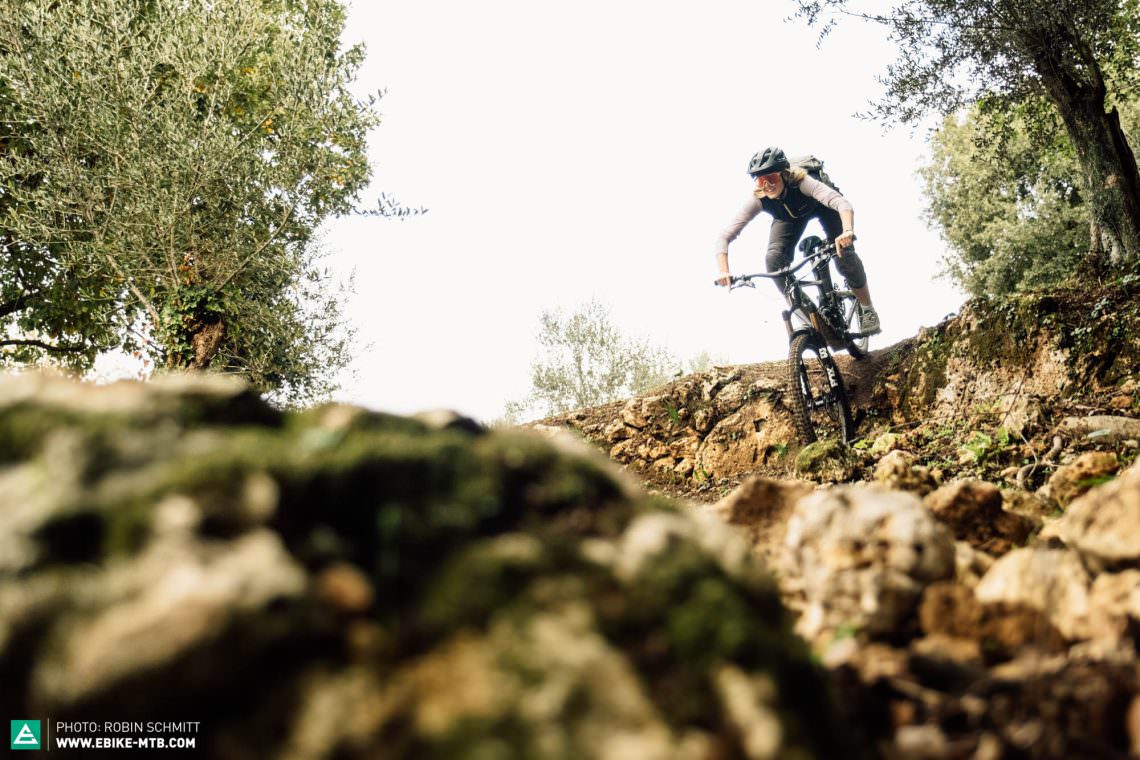
You can find out more about at specialized.com
The test field
For an overview of the test fleet head to the group test: The best eMTB of 2022 – 13 models in review
All bikes in test: FOCUS JAM² 7.0 (Click for review) | MERIDA eONE-SIXTY 10k (Click for review) | Norco Sight VLT C1 (Click for review) | Orbea Rise M-Team (Click for review) | Rocky Mountain Altitude Powerplay C70 (Click for review) | ROTWILD R.E375 PRO (Click for review) | SCOR 4060 Z ST XT (Click for review) | SCOTT Ransom eRIDE 910 (Click for review) | Specialized S-Works Turbo Levo (Click for review) | Specialized S-Works Turbo Kenevo SL | Trek Rail 9.9 XX1 AXS (Click for review) | Yeti 160E T1 (Click for review) | YT DECOY MX CORE 4 (Click for review)
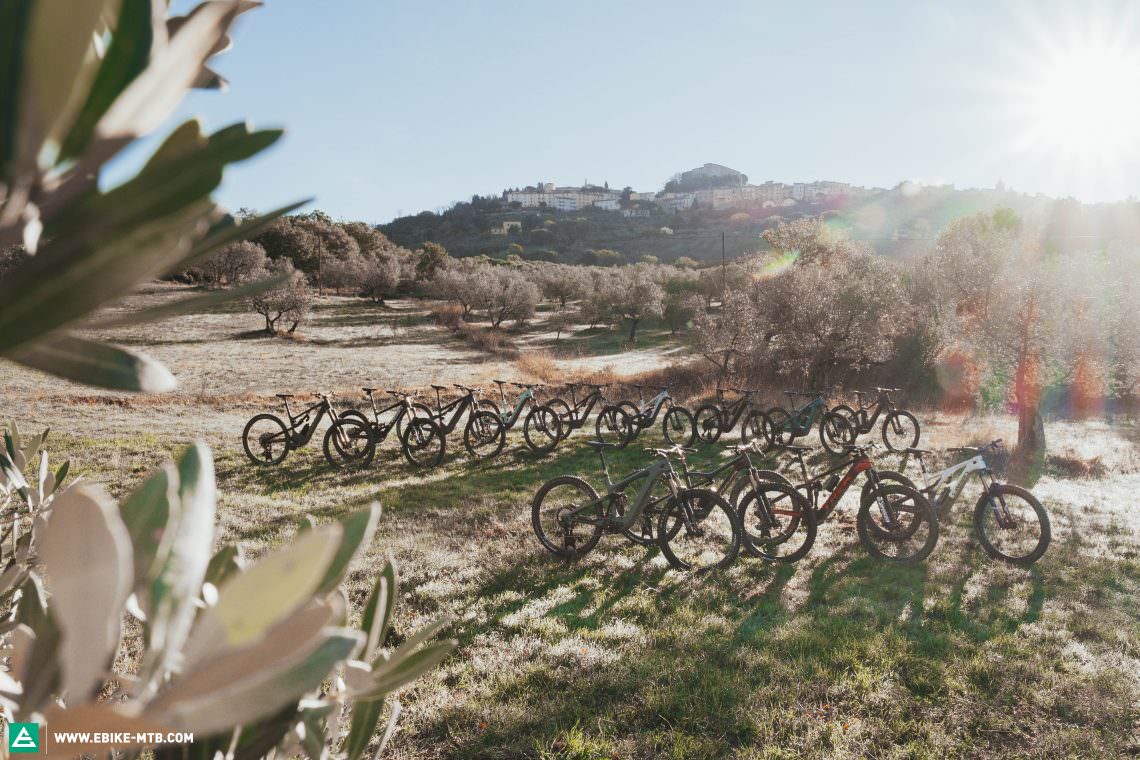
Relaxed and comfortable riding on surfaced roads, both uphill and downhill.↩
Easy climbs up trails with few obstacles, wide turns and a moderate incline.↩
Active and playful descents on easy trails with few obstacles, wide turns and a moderate slope.↩
Single-track climbs on challenging terrain. Loose ground, steps, roots, tight corners and occasionally extreme inclines.↩
Singletrack descents on challenging terrain. Loose ground, steps, roots, tight corners and small jumps as well as some very steep descents.↩
High speed descents on sometimes very rough trails with large jumps and obstacles that you can’t roll over.↩
The rating used for riding characteristics refers to the bikes in the group test and the current state of development of eMTBs. The best bikes managed to blend supposedly opposite riding characteristics, feeling both lively and stable at the same time. The handling describes the balance of the bike on downhill sections. The information regarding motor-power refers to the ride-feeling in the overall context of the bike and not exclusively to the motor – that’s why the same motor can present different values.↩
Did you enjoy this article? If so, we would be stoked if you decide to support us with a monthly contribution. By becoming a supporter of E-MOUNTAINBIKE, you will help secure a sustainable future for high-quality cycling journalism. Click here to learn more.
Words: Photos: Robin Schmitt




